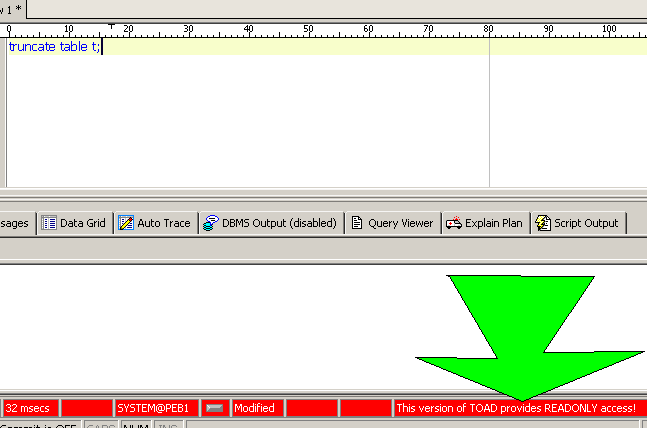I had fun answering a question about random on the technical forums.
What is in your opinion the boolean value of DBMS_RANDOM.VALUE=DBMS_RANDOM.VALUE?
Or, how many rows would
select * from dual where dbms_random.value=dbms_random.value;
return?
It is wrong to assume the function will be evaluated twice.
The short answer would be : do not rely on random plsql functions in SQL…
here is a test case in 11.2.0.2 and 10.2.0.3
SQL> select version from v$instance;
VERSION
-----------------
10.2.0.3.0
SQL> select * from dual where dbms_random.value=dbms_random.value;
no rows selected
Execution Plan
----------------------------------------------------------
Plan hash value: 1224005312
---------------------------------------------------------------------------
| Id | Operation | Name | Rows | Bytes | Cost (%CPU)| Time |
---------------------------------------------------------------------------
| 0 | SELECT STATEMENT | | 1 | 2 | 2 (0)| 00:00:01 |
|* 1 | FILTER | | | | | |
| 2 | TABLE ACCESS FULL| DUAL | 1 | 2 | 2 (0)| 00:00:01 |
---------------------------------------------------------------------------
Predicate Information (identified by operation id):
---------------------------------------------------
1 - filter("DBMS_RANDOM"."VALUE"()="DBMS_RANDOM"."VALUE"())
In 10g, the function is executed twice per row, and the chance to have two different values is more than 99.9999…%.
SQL> select version from v$instance;
VERSION
-----------------
11.2.0.2.0
SQL> select * from dual where dbms_random.value=dbms_random.value
D
-
X
Execution Plan
----------------------------------------------------------
Plan hash value: 1224005312
---------------------------------------------------------------------------
| Id | Operation | Name | Rows | Bytes | Cost (%CPU)| Time |
---------------------------------------------------------------------------
| 0 | SELECT STATEMENT | | 1 | 2 | 2 (0)| 00:00:01 |
|* 1 | FILTER | | | | | |
| 2 | TABLE ACCESS FULL| DUAL | 1 | 2 | 2 (0)| 00:00:01 |
---------------------------------------------------------------------------
Predicate Information (identified by operation id):
---------------------------------------------------
1 - filter("DBMS_RANDOM"."VALUE"() IS NOT NULL)
Here the optimized execute the function only once per row, and since the result is never null, it always evaluates to true.
Is this a bug or a feature?
In my opinion it is a confusing tuning enhancement that may break badsome programs.
In this thread, I mentioned that prior dbms_random.value is not null is an unsafe construct.
